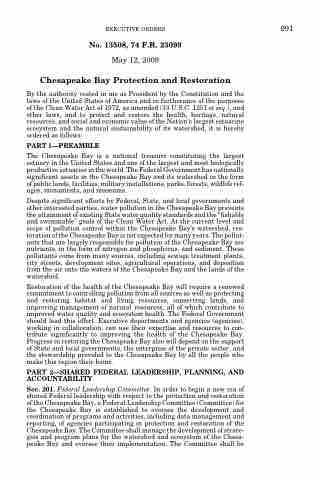Page 1001 - Demo
P. 1001
EXECUTIVE ORDERS 991
No. 13508, 74 F.R. 23099
May 12, 2009
Chesapeake Bay Protection and Restoration
By the authority vested in me as President by the Constitution and the laws of the United States of America and in furtherance of the purposes of the Clean Water Act of 1972, as amended (33 U.S.C. 1251 et seq.), and other laws, and to protect and restore the health, heritage, natural resources, and social and economic value of the Nation’s largest estuarine ecosystem and the natural sustainability of its watershed, it is hereby ordered as follows:
PART 1—PREAMBLE
The Chesapeake Bay is a national treasure constituting the largest estuary in the United States and one of the largest and most biologically productive estuaries in the world. The Federal Government has nationally significant assets in the Chesapeake Bay and its watershed in the form of public lands, facilities, military installations, parks, forests, wildlife ref- uges, monuments, and museums.
Despite significant efforts by Federal, State, and local governments and other interested parties, water pollution in the Chesapeake Bay prevents the attainment of existing State water quality standards and the ‘‘fishable and swimmable’’ goals of the Clean Water Act. At the current level and scope of pollution control within the Chesapeake Bay’s watershed, res- toration of the Chesapeake Bay is not expected for many years. The pollut- ants that are largely responsible for pollution of the Chesapeake Bay are nutrients, in the form of nitrogen and phosphorus, and sediment. These pollutants come from many sources, including sewage treatment plants, city streets, development sites, agricultural operations, and deposition from the air onto the waters of the Chesapeake Bay and the lands of the watershed.
Restoration of the health of the Chesapeake Bay will require a renewed commitment to controlling pollution from all sources as well as protecting and restoring habitat and living resources, conserving lands, and improving management of natural resources, all of which contribute to improved water quality and ecosystem health. The Federal Government should lead this effort. Executive departments and agencies (agencies), working in collaboration, can use their expertise and resources to con- tribute significantly to improving the health of the Chesapeake Bay. Progress in restoring the Chesapeake Bay also will depend on the support of State and local governments, the enterprise of the private sector, and the stewardship provided to the Chesapeake Bay by all the people who make this region their home.
PART 2—SHARED FEDERAL LEADERSHIP, PLANNING, AND ACCOUNTABILITY
Sec. 201. Federal Leadership Committee. In order to begin a new era of shared Federal leadership with respect to the protection and restoration of the Chesapeake Bay, a Federal Leadership Committee (Committee) for the Chesapeake Bay is established to oversee the development and coordination of programs and activities, including data management and reporting, of agencies participating in protection and restoration of the Chesapeake Bay. The Committee shall manage the development of strate- gies and program plans for the watershed and ecosystem of the Chesa- peake Bay and oversee their implementation. The Committee shall be


